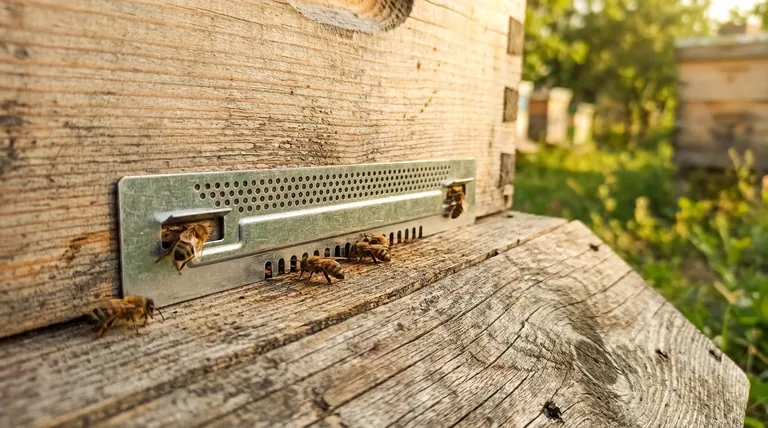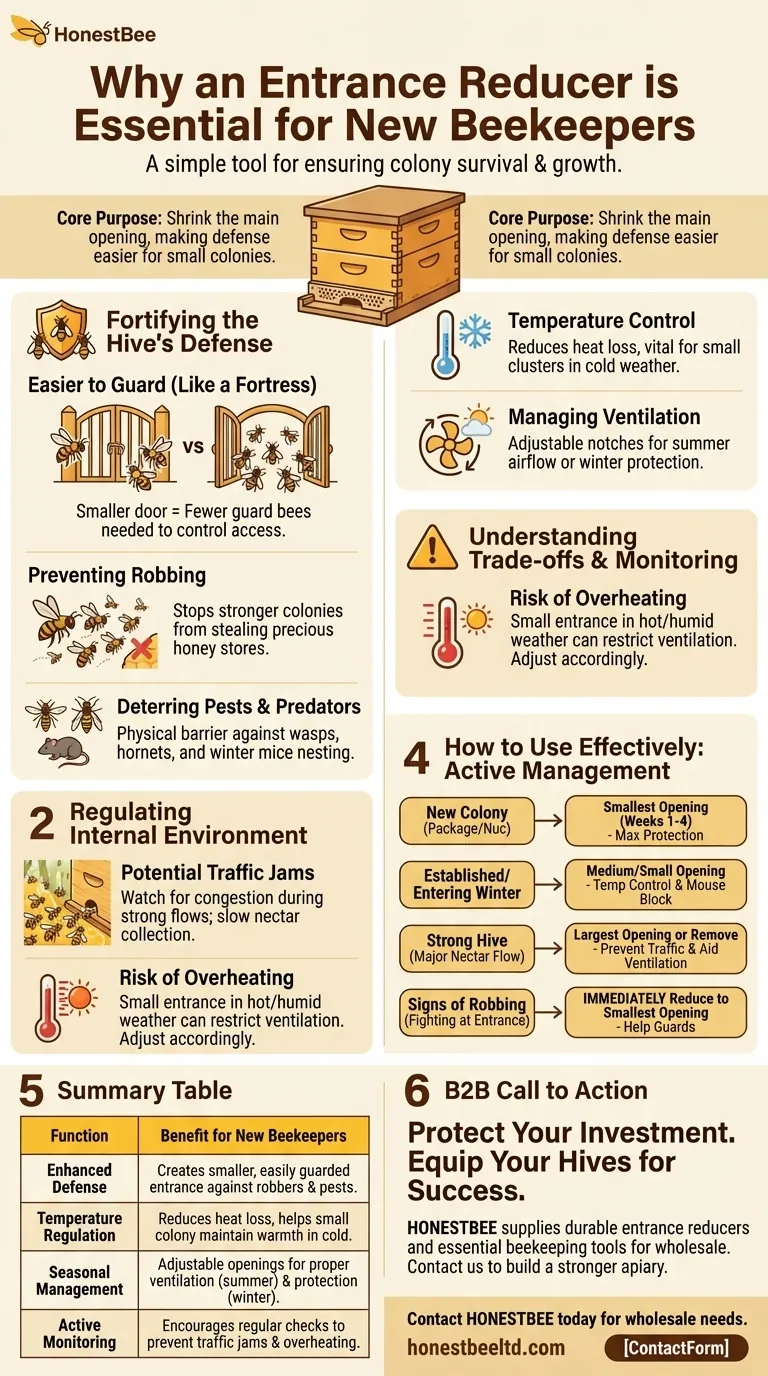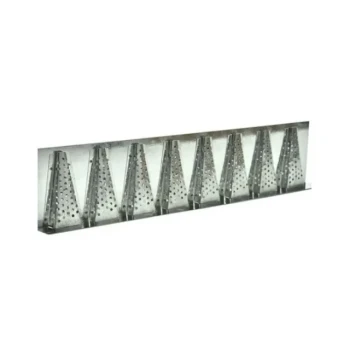As a new beekeeper, you will find the entrance reducer is one of the most important, yet simplest, tools for ensuring your colony's survival. Its primary purpose is to shrink the main opening of the hive, making it significantly easier for a small or developing colony to defend itself against robbers and pests.
The core challenge for any new bee colony is its vulnerability. An entrance reducer directly addresses this by creating a smaller, more defensible chokepoint, giving your bees the critical advantage they need to protect their home as they grow.

The Primary Role: Fortifying the Hive's Defense
For a young colony, the world is full of threats. The hive's large, standard entrance can be an open invitation for intruders. An entrance reducer acts as a simple barricade.
A Smaller Door is Easier to Guard
Think of it like defending a fortress. It is far easier to guard a single, narrow doorway than a wide-open gate.
A new colony has a smaller population and fewer guard bees. By reducing the entrance size, you allow a small number of guards to effectively control who and what comes in.
Preventing Robbing from Other Bees
"Robbing" occurs when stronger honey bee colonies discover a weaker hive and invade it to steal its honey. This is a frequent and often fatal event for new colonies.
An entrance reducer makes it much harder for waves of robbing bees to overwhelm the guards and gain access to the hive's precious food stores.
Deterring Pests and Predators
The smaller opening also provides a physical barrier against other common threats.
Wasps, hornets, and yellow jackets will find it much more difficult to slip past the guards. In winter, the reducer is essential for keeping mice from entering the hive to nest.
Beyond Defense: Regulating the Internal Environment
While defense is the main reason to use a reducer, it also helps the colony manage its internal living conditions, which is especially important for smaller populations.
Assisting with Temperature Control
Bees must work to maintain a stable temperature inside the hive, especially in the brood area. A smaller opening reduces heat loss, making this job easier.
This is particularly critical during the colder months of winter, when the bee cluster is smaller and must conserve energy to stay warm.
Managing Ventilation
Most wooden entrance reducers have two different notch sizes. These allow you to adjust the opening based on the season and the colony's strength.
While a small opening helps in cool weather, a larger one may be needed in the summer to ensure adequate airflow and prevent the hive from overheating.
Understanding the Trade-offs
An entrance reducer is a management tool, not a "set and forget" device. Using it incorrectly can create new problems.
Potential for Traffic Jams
During a strong nectar flow, a very small opening can create a "traffic jam" for foraging bees returning to the hive.
This can slow down the collection of nectar and pollen, so you must monitor the entrance for signs of congestion.
Risk of Overheating
In very hot and humid weather, a small entrance can restrict ventilation too much, increasing the risk of the hive overheating.
Be prepared to use the largest opening on the reducer or remove it entirely during heat waves, especially if the colony is strong.
The Need for Active Monitoring
An entrance reducer is not a substitute for observation. You must pay attention to your hive's activity and adjust the entrance size based on the colony's strength, the weather, and threats in the area.
How to Use an Entrance Reducer Effectively
Your decision to use a reducer, and which opening to use, should be based on your colony's specific situation.
- If you are installing a new colony (package or nuc): Use the smallest opening for the first few weeks to give the small, disoriented population maximum protection.
- If your hive is established but entering winter: Use a medium or small opening to help with temperature control and, most importantly, to block mice.
- If your hive is strong during a major nectar flow: Remove the reducer entirely or use the largest opening to prevent traffic jams and aid ventilation.
- If you observe signs of robbing (bees fighting at the entrance): Immediately reduce the entrance to the smallest possible opening to help the guard bees fight off intruders.
By actively managing the hive's entrance, you give your colony the critical support it needs to build a strong and resilient future.
Summary Table:
| Function | Benefit for New Beekeepers |
|---|---|
| Enhanced Defense | Creates a smaller, easily guarded entrance against robbers and pests. |
| Temperature Regulation | Reduces heat loss, helping a small colony maintain warmth in colder weather. |
| Seasonal Management | Adjustable openings allow for proper ventilation in summer and protection in winter. |
| Active Monitoring | Encourages regular hive checks to prevent traffic jams and overheating. |
Ready to give your new colony the best start?
As a new beekeeper, protecting your investment is paramount. HONESTBEE supplies durable, easy-to-use entrance reducers and other essential beekeeping supplies to commercial apiaries and distributors through our wholesale operations. Ensure your hives are equipped with the right tools for defense and success.
Contact HONESTBEE today to discuss your wholesale needs and build a stronger, more resilient apiary.
Visual Guide

Related Products
- Beehive Entrance Reducer Guardian Metal Hive Entrance for Bees
- Steel Round Disc Entrance Reducer for Flexzion Bee Hive Nuc Box Gate
- Multi-Functional Rotary Hive Entrance Disc for Beekeeping
- Multi-Functional Sliding Hive Entrance for Beekeeping
- Professional Galvanized Hive Strap with Secure Locking Buckle for Beekeeping
People Also Ask
- What should be done after transferring frames to the new hive? Essential Steps for a Secure Colony
- What size is the entrance hole in a native bee hive? The 13mm Standard for a Thriving Colony
- What is the purpose of placing an object in front of the hive entrance after a move? A Guide to Forced Reorientation
- What are the different types of entrance reducers available? A Guide to Protecting Your Hive
- What happens if you seal an entrance to a bee hive? Avoid a Costly Structural Disaster



















